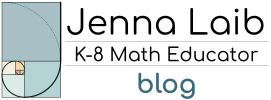
I enjoy teaching math through children’s literature. Typically, I’ll read the book aloud to a class, stopping briefly when inspired to ask a question or a student raises their hand. We then launch into an investigation I pre-planned based on the book. While I do not employ this technique much, students like the change of pace and the engaging introduction to the task. It is beautifully interdisciplinary. All is well!
I am so grateful for Allison Hintz and Antony Smith’s Mathematizing Children’s Literature (Stenhouse, 2022). (Listen to episode 2 of the Math Teacher Lounge for an interview with Allison and Tony!) It has disrupted how I think about children’s literature in math class.
The First Disruption: The Book Doesn’t Need to be Super Mathy
In my school’s library, there’s a section of “math” books. I love many of these books: classics! In Elinor J. Pinczes’ “Remainder of One,” the queen demands her bugs march in even lines, but there always seems to be a (wait for it) remainder of one. In Marilyn Burns’ “The Greedy Triangle,” a dissatisfied triangle visits a local shapeshifter who adds angle, by angle, by angle. I am madly in love with the new Storytelling Math series by Charlesbridge, in which the math is truly native to the story.
These books are beautiful and whimsical and interesting. They belong in the math classroom.
They aren’t the only books that belong in the math classroom. “A story doesn’t need to be overtly mathematical in nature to be an inspiring mathematical context,” Hintz and Smith describe in chapter 1 (7). So what happens if we “approach other stories as mathematical sensemakers?”
The Second Disruption: Read with Multiple Lenses
Previously, I read the book aloud a single time, and we’d immediately start. This time had to serve so many purposes all at once: students had to grasp the plot of the story, understand the characters, acknowledge the mathematical potential, and start mathematizing, all at once. By doing a single read, I might be shortchanging many of the literacy components.
In Mathematizing Children’s Literature, Hintz and Smith demonstrate the value of conducting multiple reads, with different lens. The first read might be an “Open Notice & Wonder.” Subsequent reads may be more focused: with a story lens, or a math lens. These reads might be a re-read of the entire book, or just a portion, or just a review of illustrations. Their goal is to activate student thinking and delve deep into mathematical or literary ideas, using what students have already generated through the “Open Notice & Wonder” as a foundation (70).
The Third Disruption: Center Student Ideas
“Over time, we came to the realization that if we wanted to hear children’s ideas, we had to stop bombarding them with questions,” Antony Smith shared in an interview (episode 2 of the Math Teacher Lounge).
I realized that, when I have used children’s literature in math class, I had pointed out critical math features in the story. I guided the questions. I posed the problem. I had done all of the mathematizing!
Students had engaged in the read aloud and activities, often with enthusiasm, but they had been given a passive role throughout most of the process.
In “Mathematizing Children’s Literature,” Hintz & Smith describe launching a literature-based experience with an “Open Notice & Wonder,” inspired by the work of Annie Fetter. It’s a time to “marvel; a time to understand the characters, setting, plot, and illustrations; to laugh, experience emotions, and fully get inside the story. It’s also a time to listen for what children notice and wonder about mathematically, unprompted.” (47)
Previously, when using children’s literature in math class, I had the entire arc of lessons planned out before I even stepped into room. Instead, Hintz & Smith propose that the ideas develop alongside and from the students. I would plan for the “Open Notice & Wonder” by anticipating what students might say, but I would leave room to be surprised, and to dig into student thinking.
From there, we’d plan the mathematical investigation together. It would need to come from the students.
And my hunch is that this would help students develop their sense of identity and agency in math class, in addition to wrestling with some of the mathematical ideas.
“Sparking Connections, Joy, and Wonder”
The full title is Mathematizing Children’s Literature: Sparking Connections, Joy, and Wonder Through Read-Alouds and Discussions.” I think that my previous work with children’s literature in math class likely sparked connections. I can think of one instance in which it sparked joy.
However, the subtitle holds so much more gravitas than I’d feel comfortable applying to these experiences. I wondered about the impact of the fact that I had prepackaged the learning experience had cut back on the connections. I wondered if not allowing for multiple reads had sacrificed some joy. I wonder if listening to and incorporating student ideas had lost some of the wonder.
To Be Continued…
I decided to try out this process with “Two Many Birds,” by Cindy Derby.
The first blog post about that experience is called “Bossy Owl: Mathematizing “Two Many Birds” In First Grade, Part 1.”


3 Comments